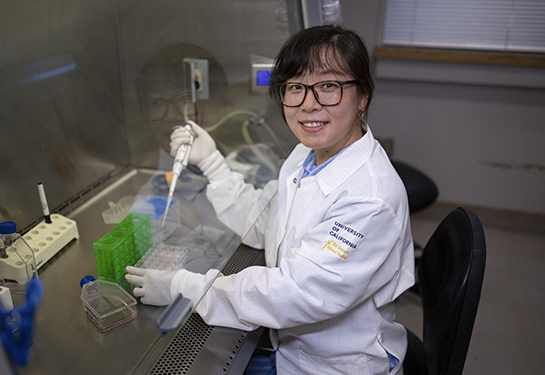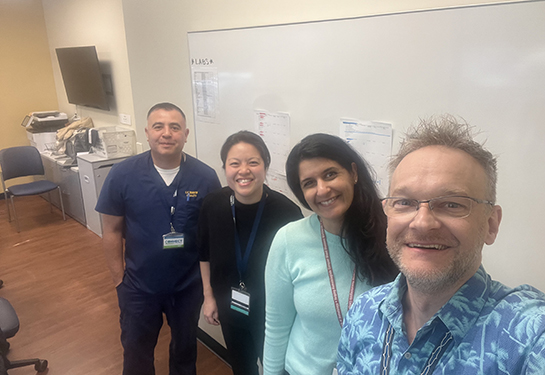New hybrid imaging breakthrough could transform detection of cancer and other diseases
$2.5 million federal grant fuels research that combines two advanced imaging technologies for greater cancer detection
The National Institutes of Health (NIH) has awarded the UC Davis Department of Radiology a National Institute of Biomedical Imaging and Bioengineering R01 Research Project Grant with a budget of $2.5 million for four years. The funding will advance a groundbreaking medical imaging technique that could significantly improve how doctors detect and understand cancer and bone and heart disease.
The innovation combines two powerful technologies — PET (Positron Emission Tomography) and dual-energy CT (Computed Tomography) — in a way that’s never been done before.
CT scans provide detailed images of the body’s internal structures. PET scans highlight areas where cells are very active. PET/CT scans are already widely used together to detect cancer and monitor how it spreads. However, traditional CT scans in PET/CT use a single energy level, which limits their ability to tell different types of tissues apart.
The new method, called PET-enabled Dual-Energy CT, changes that. It allows doctors to see not just where something is happening in the body, but also what it’s made of — without needing new machines or exposing patients to more radiation.
Dual-energy imaging provides promising results
A paper published in the European Journal of Nuclear Medicine and Molecular Imaging late last year highlights the progress of the technological development. The research was previously supported by a Trailblazer R21 Award from the NIH and resources from UC Davis Comprehensive Cancer Center.
“This is a major step forward compared to other possible solutions,” said Guobao Wang, professor of radiology and principal investigator. “We’re using the PET scan’s own data to create a second, high-energy CT image. When combined with the regular CT scan, it enables dual-energy imaging that provides a much clearer picture and more detailed information about tissue composition.”
The new hybrid PET/CT dual-energy imaging technology was invented in Wang’s lab with broad applications for cancer imaging. The research employs EXPLORER, the first-of-its-kind total body PET scanner that was invented by UC Davis Health and United Imaging Healthcare, as a platform to validate the technique.

Major benefits expected
The potential benefits are wide-ranging:
- Cancer imaging – it could help distinguish between healthy and cancerous tissues more accurately.
- Bone marrow scans – it could improve how doctors measure disease activity more accurately.
- Heart disease – it could provide new insights into the role of bone and bone marrow in systemic inflammation and cardiovascular risk.
The method also opens new possibilities for combining PET metabolic information with CT-based tissue composition in a single scan, enhancing the ability to characterize tumors and detect treatment response. Notably, the technique can be implemented on many existing PET/CT scanners without requiring new hardware.
The research team is now working to test and refine the technique. If successful, this approach could be adopted in hospitals without the need for expensive equipment upgrades — making advanced hybrid imaging more accessible to patients everywhere.
UC Davis Department of Radiology co-investigators on this grant include Ramsey Badawi, John Boone, Michael Corwin, Andrew Hernandez, Lorenzo Nardo, Benjamin Spencer. They join Naseem Esteghamat from the UC Davis Comprehensive Cancer Center. Yansong Zhu and Siqi Li, who both work in the Wang Lab, are project scientists on the research.
UC Davis Comprehensive Cancer Center
UC Davis Comprehensive Cancer Center is the only National Cancer Institute-designated center serving the Central Valley and inland Northern California, a region of more than 6 million people. Its specialists provide compassionate, comprehensive care for more than 100,000 adults and children every year and access to more than 200 active clinical trials at any given time. Its innovative research program engages more than 240 scientists at UC Davis who work collaboratively to advance discovery of new tools to diagnose and treat cancer. Patients have access to leading-edge care, including immunotherapy and other targeted treatments. Its Office of Community Outreach and Engagement addresses disparities in cancer outcomes across diverse populations, and the cancer center provides comprehensive education and workforce development programs for the next generation of clinicians and scientists. For more information, visit cancer.ucdavis.edu.




